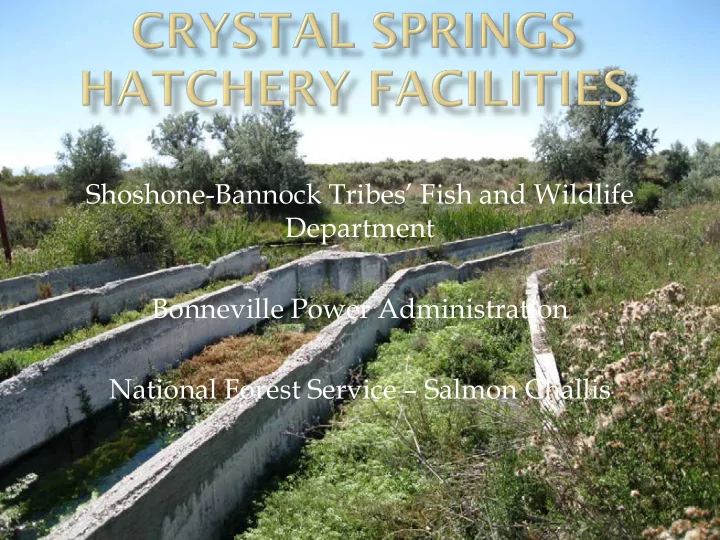

Shoshone-Bannock Tribes’ Fish and Wildlife Department Bonneville Power Administration National Forest Service – Salmon Challis
Reservation in Southern Idaho, approximately 5,600 Tribal members The Tribes harvest natural resources for subsistence under Article IV of the Fort Bridger Treaty of 1868. In 2008, the Tribes agreed to a suite of programs, including this hatchery program.
Mitigate for effects of the Federal Columbia River Power System on fish and wildlife consistent with the 1980 Northwest Power Act. Fulfill commitments made in the 2008 Columbia Basin Fish Accords agreement with the Shoshone-Bannock Tribes and others. Provide opportunities for Tribal and non-Tribal harvest. Maintain consistency with other regional plans.
The National Environmental Policy Act requires federal agencies to ‘take a hard look’ at actions before rendering a decision. The NEPA process is intended to produce decisions that blend resource condition in productive harmony with our use of the environment. In this case, the potential use of federal funds for a hatchery and federal lands for salmon management trigger NEPA.
NEPA and its implementing regulations spell out a process for developing the environmental review; for this project, we will develop an Environmental Impact Statement (EIS). The goal is to finalize the EIS by the Spring 2016. 2015 2014 2016 Field studies and drafting Revise the Draft EIS Scoping Period Begins Publish the Draft EIS Final EIS and ROD
The Yankee Fork and Panther Creek spring Chinook programs have the following conservation, harvest and cultural objectives: Cultural Objective: Tribal members would have opportunities to harvest using traditional and contemporary methods. Harvest Objective: The program will provide, on average, approximately 1,000 Chinook in the Yankee Fork and 800 Chinook in Panther Creek for harvest. Conservation Objective: The programs will contribute to the recovery of the Snake River spring/summer Chinook ESU by restoring a Maintained population of 500 locally adapted Chinook spawners in the Yankee Fork and 500 spawners in Panther Creek (a total of 1,000 fish).
Adult Escapement Yankee Fork Salmon River Panther Creek Priority Hatchery Broodstock 358 (NOR+HOR) adults 214 (NOR+HOR) adults Natural Escapement ~500 (NOR+HOR) adults ~500 (NOR+HOR) adults Harvest ~1,000 (NOR+HOR) adults ~800 (NOR+HOR) adults *Yankee Fork production targets for smolt production range from 450,000-600,000 smolts. **Panther Creek production targets for smolt production range from 300,000- 400,000 smolts.
The Tribes will initially produce 10,000 catchable trout for release in the Fort Hall Bottoms to supplement harvest opportunities. The Tribes may opt for multiple release strategies if monitoring provides sound guidance.
The Panther Creek system was also key to the subsistence lifestyle of the people. Unfortunately, this system was also heavily impacted by the effects of mining activities. The local population of Chinook was determined to be extirpated.
Recommend
More recommend